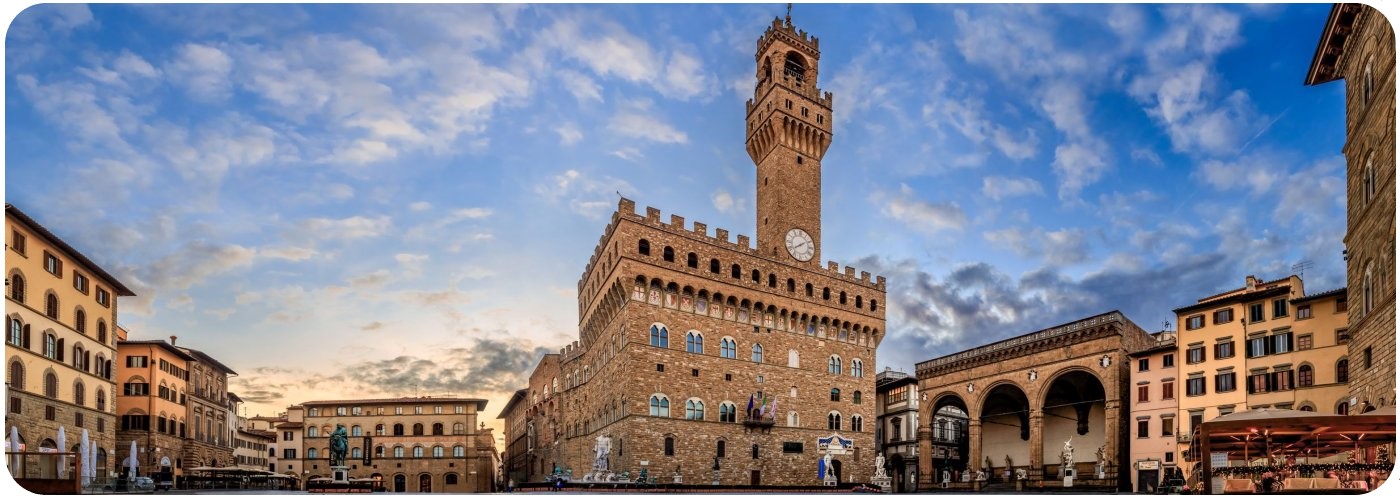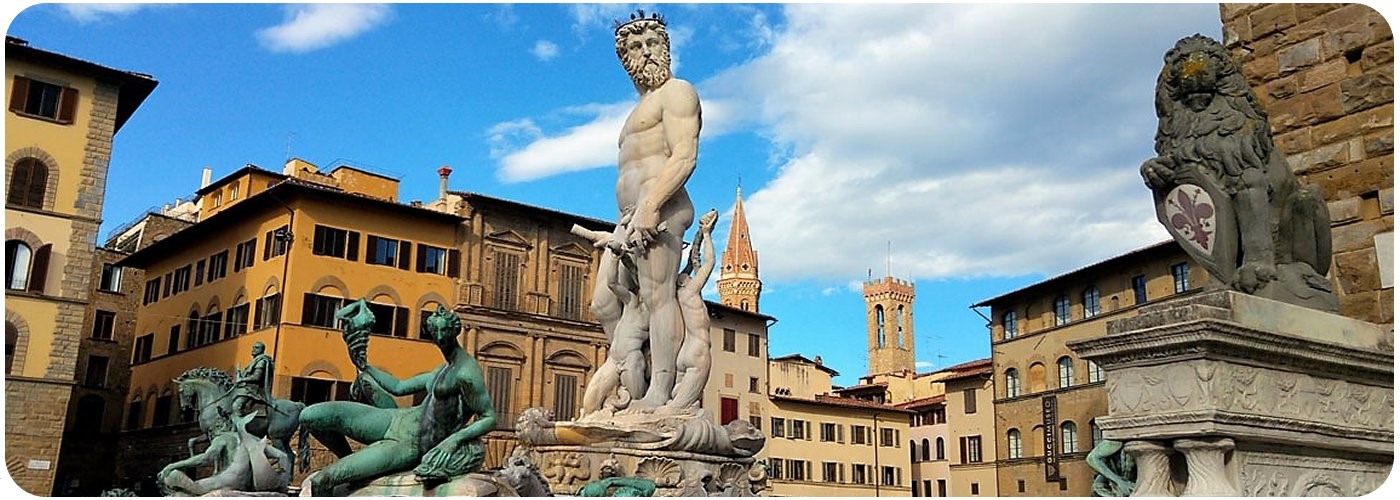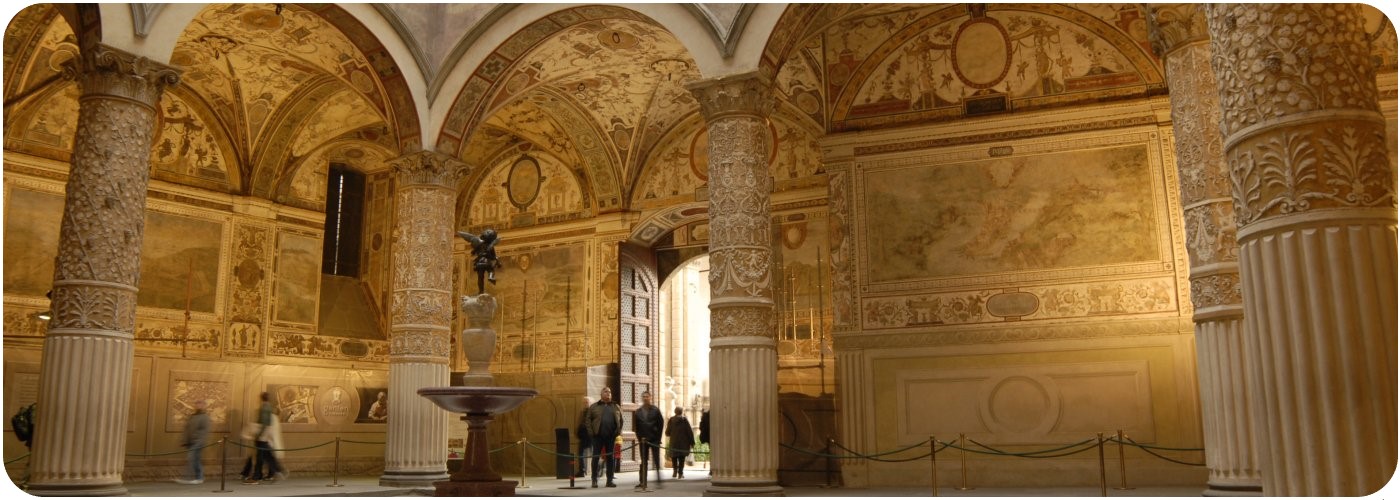Piazza della Signoria
The name “Piazza della Signoria” comes from the Florence’s town hall, Palazzo Vecchio, that was previously called “Palazzo della Signoria”. Piazza della Signoria has been and still is the political focus of the city, visited by million tourists (and Florentines!) every year.
Piazza della Signoria was already a central square when Florence was a Roman town called Florentia. At that time it was surrounded by Roman baths and a theater, later they built there a church consecrated to San Romolo and a 5th century basilica.

The history of Piazza della Signoria
Piazza della Signoria started taking shape in 1268, after the houses of the Ghibellines (those who supported the imperial party) were demolished by the Guelphs (those who supported the Pope). The square remained empty for many years and it was paved in 1358 for the first time.
Piazza della Signoria has been also the place where Girolamo Savonarola (the Dominican friar) with his followers, carried out the famous “Bonfire of the Vanities”: they burned gaming tables, books, works of poets and dresses.
Unfortunately for Girolamo Savonarola, Piazza della Signoria was also the place where he was hanged and then burned in 1498. Still today in front of the fountain of Neptune you can see a round marble plaque marking the spot where he was executed.
Piazza della Signoria was repaved in the 1980s and during the works they found an archaeological treasure: remains of a Neolithic site.
Among the buildings that you can find in Piazza della Signoria there are: Palazzo Vecchio (the Old Palace), seat of the local government, the Uffizi Gallery, one of the most important museums of the world, the Palace of the Tribunale della Mercanzia, today the seat of the Bureau of Agriculture, the Palazzo Uguccioni, a beautiful Renaissance palace, the Palace of the Assicurazioni Generali and the Loggia dei Lanzi.

Palazzo Vecchio, the town hall of Florence
In 1299 the Florentines decided to build a palace that represented the importance of the city and a building that was safe and easy to defend in case of riots or turbulence. The construction of the palace began on the ruins of two palaces that belonged to the Uberti family: the Palazzo dei Fanti and the Palazzo dell'Esecutore di Giustizia.
It was originally called "Palazzo della Signoria" from the name of the governing body of the Republic of Florence, the Signoria. Over the centuries it was also given several other names such as: Palazzo Ducale, Palazzo del Popolo or Palazzo dei Priori. The name Palazzo Vecchio was acquired when the ducal residence of the Medici was transferred to Palazzo Pitti.
It was designed by the architect Arnolfo di Cambio who worked on the Duomo of Florence and according to Vasari's "Lives of the Excellent Painters, Sculptors and Architects" also on the Basilica of Santa Croce.
This choice was not accidental: the members of the Uberti family were considered "rebels" and building a new palace on the ruins of their possessions had an important meaning for the Florentines: their house would never be rebuilt in the same place.
In May 1540, Duke Cosimo I de 'Medici transferred the official seat of the Signoria to Palazzo Vecchio, which acquired this name when he again moved the seat to Palazzo Pitti.
To connect the two buildings, the Duke commissioned Giorgio Vasari to create an above-ground walkway, the so-called "Vasari corridor", which connected the Palazzo Vecchio with Palazzo Pitti, across the Uffizi and Ponte Vecchio.
From 1865 to 1871 the Palazzo Vecchio acquired new importance as the seat of the provisional government of united Italy, when Florence was the temporary capital of the new Kingdom of Italy.
Palazzo Vecchio remains the symbol and center of the local government: since 1872 it has housed the office of the mayor of Florence and is the seat of the municipal council.

The architecture of Palazzo Vecchio and its clock tower
Palazzo Vecchio is a cubic building made of solid ashlar masonry. It has two orders of Gothic mullioned windows with a trefoil arch. In the 15th century, the artist Michelozzo Michelozzi added bas-reliefs depicting the Florentine lily and a cross in the pendentives between the trefoils.
On top of Palazzo Vecchio there is a crown made of projecting crenellated battlement, supported by corbels and small arches. Under these arches there are 9 painted coats of arms of the Florentine Republic that are repeated in series. Some of the arches were used as embrasures fro dropping rocks or heated liquids on invaders.
Palazzo Vecchio is enhanced by the tower (height 94m) with its clock, and according to some documents the architect Arnolfo di Cambio incorporated the ancient tower of the Foraboschi family into the new tower’s façade.
This is the reason why the tower is not directly centred in the building. The clock was originally constructed in 1353 by the Florentine artist Nicolò Bernardo, but in 1667 it was replaced by a replica made by the German Georg Lederle.
In the tower of Palazzo Vecchio there are two small cells that imprisoned two important men: in 1435 Cosimo de’ Medici (the Elder), the first member of the Medici political dynasty, and in 1498 Girolamo Savonarola, the Dominican friar who was executed in front of Palazzo Vecchio.
At the entrance of Palazzo Vecchio there is a copy of the Michelangelo’s David, considered one of the masterpieces of the Renaissance. The original stood there from 1504 to 1873 when it was moved to the Accademia Gallery. The replica was realized in 1910 and is flanked by Baccio Bandinelli’s Hercules and Cacus.
Our 10.30 am walking tour stops in Piazza della Signoria. Our guides will show you all its beauties in detail.